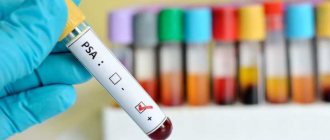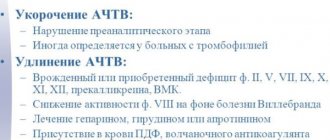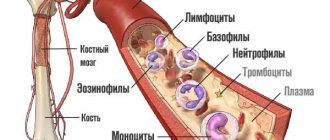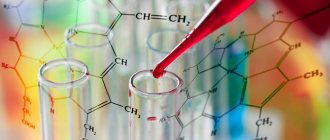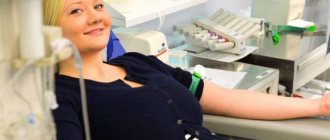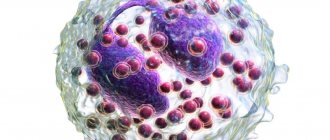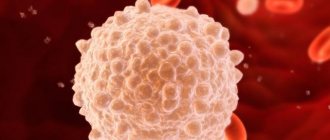What is a hematological blood test, deciphering its indicators - such questions concern many patients. This is a general blood test that involves a full check, during which it is necessary to identify the level of platelets, red blood cells, leukocytes, and also determine the concentration of hemoglobin. It also involves assessing the color index and the rate at which red blood cells settle, as well as the leukocyte formula.
The listed indicators usually have constant values. But they can change if a person is sick. A blood test, in cases where it is complete, is a common method that can help in making a medical report. Changing indicators does not allow an accurate diagnosis to be made, but only reflects the general state of a person’s health. There is no need for special preparation. The blood test should be done on an empty stomach or when more than two hours have passed since eating.
Analysis transcript
To perform a hematological analysis, control blood is used as starting material.
This is a mixture of preservatives, blood cells and a special liquid similar in composition to plasma. A vein or ring finger is used to collect it. The procedure is carried out only in laboratory conditions. The pain is minimal, and it takes no more than thirty minutes. After examining the biological material in the laboratory, you can obtain the research results. In more detail it looks like this:
- WBC is the white blood cell concentration.
- RBC – red blood cells, their number.
- RE – reticulocyte concentration.
- HGB – hemoglobin level.
- PLT – platelet cell content.
- MCH is the hemoglobin content per unit of red blood cells.
- HCT – hematocrit.
Preparing for the study
To carry out this study, control blood is used for the analyzer, a mixture of blood cells, preservatives and a certain liquid that resembles plasma in structure.
Blood sampling for testing is carried out in the morning on an empty stomach; you are allowed to drink only regular still water. The material is taken from a vein in the elbow or from a finger.
Before passing, special preparation is required, which includes a number of simple rules:
- For three days before the procedure, you should not take medications that affect blood clotting. You must inform your doctor about taking other medications immediately before submitting the biomaterial, this will make it possible to avoid misinterpretation of the study results.
- Avoid drinking alcoholic beverages.
- Do not eat fatty, spicy, fried foods.
- Do not drink strong tea or coffee 8 hours before donating blood.
- On the day of the test, do not smoke, as the presence of nicotine in the body causes spasms of blood vessels.
Eosinophils
Eosinophils remove toxic substances and their breakdown products from the body. They determine how well wound healing and regeneration of damaged tissues will proceed, as well as resistance to allergens.
The norm in adults is from 1 to 5% in the leukocyte formula. An increase in eosinophils is recorded in various allergic reactions, helminthic infestations, the growth of malignant tumors, liver cirrhosis and gastrointestinal ulcers.
The peculiarity of these cells is that their increase in infectious diseases indicates the beginning of the patient’s recovery. The number of eosinophils decreases with general exhaustion of the body, frequent stress, lack of sleep, and the postoperative period.
The best hematologists
Make an appointment by phoneAdd to comparison33 reviews 9.2 rating Kuznetsov Sergey Vadimovich HematologistExperience 33 years. Doctor of the highest category Cost of appointment - 2950 rubles. 1920r. only on medportal.net!
Make an appointment by phone. Engaged in the diagnosis and treatment of diseases such as leukemia, lymphogranulosis, lymphoma, anemia, hemophilia, multiple myeloma and other blood diseases and pathologies of the hematopoietic organs. Moscow, Prospekt Mira, 105, building 1. Alekseevskaya, VDNH Make an appointment by phone 8 (499) 519-35-82 Add to comparison219 reviews 9.5 rating Pavlova Olga Alekseevna Hematologist Experience 25 years. Candidate of Medical Sciences Doctor of the highest category Cost of appointment - 3490 rubles. Make an appointment by phone Hematologist. Conducts diagnosis and treatment of hematological diseases, chronic lymphoproliferative diseases, hemostasis disorders. Proficient in techniques for performing bone marrow puncture and trepanobiopsy of the ilium. Author of chapters in the national guide “Oncology”, clinical recommendations “Oncology”, more than 20 publications in scientific journals. Moscow, st. Nizhnyaya Krasnoselskaya, 15/17. Baumanskaya, Komsomolskaya, Krasnoselskaya Make an appointment by phone Add to comparison19 reviews 8.8 rating Fedulova Anna Anatolyevna Hematologist Experience 25 years. Doctor of the highest category Cost of appointment - 3500 rubles. Make an appointment by phone. Provides care for inpatient and outpatient patients and treats hematological patients, and also provides care for pregnant women with genetic thrombophilia and other hematological diseases, and prepares for IVF.g. Moscow, Volgogradsky Prospekt, 42, building 12. Tekstilshchiki Make an appointment by calling 8 (499) 519-35-82 Add to comparison63 reviews 8.4 rating Shirokov Alexey Sergeevich Hematologist 13 years of experience. Cost of appointment - 3500 rubles. Sign up for appointment by phone Engaged in the diagnosis and treatment of hematological diseases, malignant and non-malignant blood diseases, anemia of pregnant women, thrombophilia. Moscow, st. Klara Zetkin, 33, bldg. 28. Voykovskaya, Baltiyskaya
Lymphocytes
Lymphocytes, responsible for maintaining immunity at the proper level, can exist for more than 10 years, carrying immune memory. That is why many diseases can only be suffered once in a lifetime. They contain approximately 19-37% in the blood.
With the help of lymphocytes, mutated cells carrying distorted information are destroyed. However, a sharp increase in their number may be a manifestation of a tumor developing in the bone marrow. A slight increase is observed in cases of viral infections. A lack of lymphocytes is caused by bacterial infections or lymphoma.
This is what a hematological blood test reveals. But that's not all.
More information about hematological blood tests
A hematological blood test is a study of a person’s biological material, which allows one to draw various conclusions about his general condition.
This analysis is one of the most common in modern medicine. If you want to know what this research is and how it is deciphered, then read this article.
In addition, in this material you can find information about what pathological conditions of the body can be identified by passing a hematological analysis.
What does this analysis show?
Thanks to a hematological blood test, the laboratory technician receives detailed information about the following indicators:
- Red blood cells - erythrocytes.
- A color indicator of blood that displays the level of hemoglobin in red blood cells.
- White blood cells - leukocytes.
- Neutrophils, responsible for the body's resistance and resistance to infectious pathogens.
- Erythrocyte sedimentation rate (abbreviated ESR).
- Eosinophils, responsible for the fight against so-called parasitic infestations and various types of allergens.
- Basophils are blood cells that secrete histamine.
- Monocytes are one of the key cells responsible for the state of the human immune system.
- Lymphocytes necessary for the body to fight various types of viral and bacterial infections.
- Platelets, responsible for blood clotting.
- Reticulocytes, which are insufficiently matured forms of red blood cells.
- The percentage of different subtypes of leukocyte cells in the general blood formula.
Therefore, in case of suspicion of a number of serious diseases or if it is difficult to establish an accurate diagnosis, a clinical blood test is irreplaceable.
Interpretation of the results obtained
Decoding of the analysis indicators is carried out by qualified specialists based on the information provided by the hematology analyzer. In order to correctly interpret the data obtained, it is necessary to know the norms of basic blood parameters. Let's look at this issue in more detail:
- The leukocyte count norm is (4-9) x 10 9/l.
- The normal erythrocyte content is (3.80-5.10) x 1012/l.
- The normal hemoglobin content is 0.90-1.10.
- The normal erythrocyte sedimentation rate is up to 8-12 mm/h.
- The normal platelet count is 180 - 320 *109/l.
- The normal lymphocyte content is 1.2-3.0x109/l.
- The normal level of monocytes is 0 - 0.08 x 109/l.
- The normal reticulocyte content is 0.24 - 1.7%.
- The norm for basophil content is 0.01 - 0.065 * 109 g/l.
- The normal content of eosinophils is 1 - 5%.
- The normal hematocrit content is 42-50%.
- The norm is 11.5-14.5%.
- The normal hemoglobin content in an erythrocyte cell (blood color indicator) is 26-34 pg.
- The normal volume of an erythrocyte cell is 80-100 fl.
For neutrophils, the following standards exist:
- Bands - 1-4%.
- Segmented - 40-60%.
If these indicators, according to the analysis results, deviate from the norm, then this is a clear sign of the presence of certain diseases, inflammatory or infectious processes in the patient’s body. Hematological analysis is one of the most reliable modern diagnostic procedures that allows us to identify various types of pathologies in the body at the earliest stages and determine their possible causes. This allows the patient to receive correct and timely treatment and avoid the development of various complications and negative consequences.
Interpretation of hematological blood tests
After drawing blood, the doctor sends the biological material to the laboratory. Next, the material enters a special apparatus - a hematology analyzer, where it interacts with various reagents.
READ Preparing for a general blood test – should you take it on an empty stomach or not?
The results of the study and its interpretation using this device are prepared within a few minutes.
The test results form contains information that is understandable only to doctors.
That is why the interpretation of such a study as a hematological analysis cannot be carried out by the patient himself.
However, anyone can familiarize themselves with general information regarding the decryption process.
The form with the research results contains several columns with abbreviations.
You can find out their meaning below:
- WBC – number of leukocytes in control blood;
- RBC – red blood cell count;
- RE – reticulocytes;
- HGB – hemoglobin;
- PLT – platelets;
- MCH – amount of hemoglobin in an erythrocyte cell;
- HCT – hematocrit.
In addition to the volume of declared chemical units, the transcript of the analysis of biological material collected from the patient contains the following data:
- about the processes of the body's resistance and its immunity (neutrophils, monocytes);
- about the presence or absence of parasitic infestations (eosinophils);
- about possible allergic reactions (basophils).
Completing the study allows you to create a fairly accurate clinical description of a person’s condition.
The standard content of all of the above elements in the blood of an adult healthy person is collected in a table, which can be found below.
| Index | Content standard |
| Leukocytes | 4 – 9*109/l |
| Red blood cells | 3.80 – 5.10*1012/l |
| Normal hemoglobin content | 0,9 – 1,1 |
| Erythrocyte sedimentation rate (ESR) | From 8 to 12 mm/h |
| Platelets | 180 – 320*109/l |
| Reticulocytes | 0,24 – 1,7 % |
| Basophils | 0.01–0.065*109 g/l |
| Lymphocytes | 1.2 – 3*109/l |
| Monocytes | 0 – 0.08*109/l |
| Red blood cell distribution width | 11,5 – 14,5 % |
| Eosinophils | 1 – 5 % |
| Hematocrit | 42 – 50 % |
| Blood color index | 26 – 34 pg |
| Red blood cell volume | 80 – 100 fl. |
Hemoglobin, color index
Hemoglobin is a protein with a complex structure that is a component of red blood cells. The main function is to direct oxygen from the lungs to the tissues and eliminate the products resulting from its processing. Hematology regards an increased concentration of hemoglobin as a result of significant physical exertion, polycythemia, poor oxygen saturation of the blood, and loss of a significant amount of fluid by the body.
A decrease in this protein can occur due to the loss of some amount of blood or as a result of problems in its production or disturbances in the process of formation of red blood cells. The standard value is 132-173 g/l. For children it has different meanings. A low hemoglobin concentration may indicate the presence of anemia.
The color of the blood makes it possible to determine the type of this disease:
- normochromic - hemoglobin within reasonable limits;
- hyperchromic - there is too much of it in the red blood cell;
- hypochromic - the amount of protein in the red blood cell is very small.
Preparation for analysis in hematology
A detailed blood test in hematology and interpretation in adults is carried out in the morning, on an empty stomach. Preparations for it should begin several days in advance.
To do this you need to do the following:
• A few days before donating blood, it is not recommended to take medications that affect the rate of blood clotting;
• Tea and coffee should be removed from the diet two hours before the test;
• 3 days before the test, exclude fatty and fried foods and alcohol from your diet;
• Immediately on the day of the study, you must stop smoking, as nicotine provokes spasms in the blood vessels;
• Do not carry out the analysis if the human body is susceptible to a viral infection, since blood hematology indicators will be distorted;
• The last meal should be 2 hours before blood donation;
It is necessary to adhere to these rules so that the conducted research shows more accurate results!
Neutrophils
Neutrophils, which account for over 72% of all types of leukocytes. These small cells are located mainly in the tissues of the human body, their proportion in the blood is insignificant. This arrangement is due to the fact that neutrophils must be the first to find a place infected with pathogenic bacteria and neutralize them.
An increase in their number is facilitated by bacterial or fungal infections, inflammatory processes, the occurrence of neoplasms, bleeding, tissue damage, and some medications. A decrease is observed when receiving the virus and the dose of radiation.
How to prepare for the analysis?
Clinical detailed analysis is carried out in the morning, on an empty stomach. You should start preparing for it a couple of days in advance. To do this, it is recommended to follow a few simple rules:
- Two to three days before the test, you should stop taking medications that affect blood clotting.
- Eliminate fried and fatty foods and alcoholic drinks from your diet for this period.
- It is not recommended to drink tea or coffee later than two hours before the test.
- On the day of the test, you should refrain from smoking, since nicotine promotes spasms in peripheral vessels.
- A clinical blood test is not recommended if there are viral infections in the body, as this may distort the overall picture.
- The last meal should be no later than two hours before blood sampling.
Compliance with the above rules is necessary to ensure that the examination gives the most accurate results!
What does a hematological analysis show?
The doctor receives detailed information:
about red blood cells - erythrocytes; about ESR, an important indicator of erythrocyte sedimentation rate; about eosinophils, responsible for the removal of parasitic infestations and allergens; about basophils - blood cells responsible for the release of histamine; about platelets, which are responsible for blood clotting; about reticulocytes, which are immature red blood cells, so to speak, their strategic reserve, confirming that blood functions are normal.
Today, such a detailed clinical picture can only be obtained using hematological analyzers; there is no other way yet. And the doctor also needs to know the number of monocytes, key cells of the immune system; and the number of lymphocytes that fight infections of viral and bacterial origin.
Doctors see the early stage of any disease or pathological process. This study does not require special efforts from the patient, so blood is taken for analysis from both adults and children; the norm in the table helps to decipher the results.
Hematological blood test - explanation (table with standards):
| Leukocytes | (4-9) x 10 9/l |
| Red blood cells | (3.80-5.10) x 1012/l |
| Hemoglobin | 0,90-1,10 |
| Erythrocyte sedimentation rate | up to 8-12 mm/h |
| Platelets | 180 – 320 *109/l |
| Lymphocytes | 1.2-3.0x109/l |
| Monocytes | 0 – 0.08 x 109/l |
| Reticulocyte | 0,24 – 1,7% |
| Basophils | 0.01 – 0.065 * 109 g/l |
| Eosinophils | 1 – 5 % |
| Hematocrit | 42-50% |
| Red blood cell distribution widths | 11.5-14.5% |
| Blood color index (hemoglobin) | 26-34 pg |
| Red blood cell volume | 80-100 fl |
The readings are deciphered by a qualified specialist based on data obtained from a hematology analyzer. The correct interpretation is obtained by comparing the data from the analyzer with the standard indicators of the table.
If the obtained indicators deviate from the norm, this indicates the presence of a certain disease, inflammation or infectious process.
Hematological analysis is the most reliable diagnostic method that allows us to identify different types of pathologies at an early stage and help determine their causes. During treatment, control tests are repeatedly taken to check the effect of the medicine and the correctness of the chosen direction of treatment.
Hematological blood test - what does it show and why is it needed?
Blood tests for various purposes are considered the main diagnostic procedures, important and very informative in determining the picture of the general condition of a sick person and drawing up an expanded clinical diagnosis.
The content of the article
- Hematological blood test - what does it show and why is it needed?
- How is the analysis carried out? This is the transcript of the analysis results, which shows:
- The doctor receives detailed information:
When receiving a ready-made hematological blood test for adults from the laboratory, the doctor makes the decoding, checking the norm tables determined by gender and age. A blood test most accurately clarifies the expected diagnosis, determines the type of infection, the state of the immune system, and possible damage to the hematopoietic system.
Any sick person knows that the first thing the doctor will prescribe for him will be blood tests from a finger and a vein.
It is necessary to prepare for such an analysis in advance. Blood is drawn in the morning, on an empty stomach. In addition, 2-3 days before donating blood, you must stop taking medications that affect blood clotting, even if the medicine is prescribed by a doctor and taken according to the regimen. In the days leading up to the analysis, it is necessary to exclude alcohol from the diet, as well as everything fried, salty, and fatty.
A classic option for maintaining any diet, which is very important for a complete deciphering of a hematological blood test.
In addition, nicotine causes peripheral vessels to experience sharp spasms, which will undoubtedly affect the results of a blood test. A clinical test is not prescribed by a doctor for an obvious viral infection, since it is clear that the presence of a virus will distort the picture of the result. These rules are important for accurately deciphering the analysis in adults and children. It is necessary to follow these rules in order for the blood test to be as accurate as possible.
https://youtu.be/9F0z4E9_a8Q
Transcript of the report
Based on the above, we realized that when deciphering the analysis report, such parameters as hemoglobin level, leukocyte count, erythrocyte count, erythrocyte media volume, average hemoglobin concentrate in erythrocyte, and platelet count are involved.
So, let’s decipher the main indicators that are provided to us in the report:
- WBC is nothing but white blood cells. Acceptable indicators are from 4 to 9* 109/l.
- RBC - red blood particles determine the exact number of red blood cells in the blood. For women and men, acceptable indicators differ slightly in the upper range. The norm for women is 3.5-4.5 * 1012, for men 3.5-5.5 * 1012.
- HGB is considered a parameter of hemoglobin in the blood, where normal values for a man are 130-150 g/l, and for a woman 120-140 g/l.
- HCT is a hematocrit that shows the number of red blood cells directly in the blood plasma. The norm is expressed as a percentage and ranges from 0.39 to 0.49.
- PLT - platelets that show the absolute value of platelets in the blood. The main component is to stop bleeding.
Red blood cell indices:
- MCV - average erythrocyte volume.
- MCH is the average number of hemoglobin in an individual red blood cell.
- MCHC is a medium-value concentrate found in hemoglobin.
Platelet indices:
- PDW – platelet heterogeneity value
- MPV – average platelet volume.
- PCT - thrombocrit is considered to be part of the volume of the basis of the platelet.
Naturally, for the hematological study performed, its own standards were predetermined. When deciphering each indicator, it is necessary to take into account the reference values of the laboratory where the analysis is actually carried out. As a rule, automatic hematology analyzers create graphs on their own, and the specialist only examines them and prescribes (if there is an infection) or does not prescribe (if there is no infection) medications.
Our service will select the best hematologist for you free of charge when you call our Unified Appointment Center by phone. We will find an experienced doctor near you, and the price will be lower than if you contact the clinic directly.
Application for free selection of a doctor Our operator will call you back within 10 minutes and recommend a doctor
By submitting this form, you agree to the Rules
Sources
- https://krovinfo.com/gematologicheskij-analiz-krovi/
- https://moydiagnos.ru/analizi/krovi/gematologicheskij.html
- https://astery-med.ru/service/diagnostika/gematologicheskie_issledovaniya/
- https://medportal.net/gematologicheskij-analiz/
- https://1diagnos.ru/laboratornye-issledovaniya/krovi/gematologicheskie/gematologicheskiy-analiz-krovi.html
- https://AnalizyPro.ru/vidy-analizov/gematologicheskogo-analiza-krovi.html
- https://fb.ru/article/302472/gematologicheskiy-analiz-krovi
Carrying out analysis
A clinical blood test is the most important diagnostic procedure; it is carried out to accurately assess the state of health and is used to determine the effectiveness of prescribed therapy.
There are a number of reasons for this:
- The course of pregnancy with complications.
- Suspicion of anemia.
- Routine examination of the patient.
- Inflammatory reactions.
- Presence of infection.
- Preparatory stage before surgery.
- Rehabilitation period after surgery.
- Suspicion of cancer.
- Presence of parasites (helminthic infestation).
- Assessment of blood composition, blood pathology.
- Suspicion of diseases of the hematopoietic organs.
- Pathologies of the heart and blood vessels.
- Kidney diseases.
- Diseases of the bone structure.
- Presence of viruses.
A clinical blood test is deservedly considered one of the main diagnostic procedures necessary to determine the general health of the patient, as well as to compile an expanded clinical picture. In most cases, the indications for this study are the following:
- Suspicion of anemia.
- Complicated pregnancy.
- Planned therapeutic examination.
- Inflammatory processes in the body.
- Infectious diseases.
- Preparation for surgery.
- Postoperative period.
- Suspicion of an oncological tumor.
- Worm infestation.
- Definition of blood diseases.
- Suspicion of pathology of the hematopoietic organs.
- Helminthiases.
- Suspicions of diseases of the cardiovascular system.
- Presence of renal pathologies.
- Lesions of the skeletal system.
- Detection of viral diseases.
In addition, a clinical blood test is prescribed to clarify the suspected diagnosis. This study allows us to determine the type of infection, which can be either viral or bacterial, the adequacy of the immune system, and the degree of damage to the hematopoietic system.
To carry out the presented analysis, the material used is so-called control blood, which is a mixture of blood cells, preservatives and a special liquid resembling plasma in its composition. Blood sampling for the base can be taken either from the patient's vein or from the ring finger. This largely depends on the main purpose of the study.
The procedure takes place in laboratory conditions, it is practically painless and takes no more than half an hour. After this, the biological material is transferred to the laboratory, where it is examined using a special laboratory device - a hematology analyzer.
This happens as follows. A test tube with control blood is placed in an electric device filled with a special type of reagents, and literally in a matter of minutes the device issues a form with printed results, which include: the state of blood cells, reticulocytes, hemocrit, hemoglobin level and the general leukocyte formula containing accurate information up to to the number of granulocytes.
The most powerful and expensive hematological analyzers, among other things, determine the level of lymphocytes, monocytes, neutrophils, eosinophils in the patient’s blood, as well as their condition. The presented device is characterized by increased accuracy and reliability. In addition, the use of equipment greatly facilitates the doctor’s work and saves a lot of time, since in this case the analysis results are provided literally in five to ten minutes. The decoding of the abbreviation presented in the hardware form is as follows:
- WBC (White Blood Cells)" - level of leukocytes.
- RBC (Red Blood Cells) - level of red blood cells.
- RE (Reticulocytes) - content of reticulocytes.
- HGB (Hemoglobin) - hemoglobin.
- PLT (Platelet) - platelet cells.
- MCH (Mean Cell Hemoglobin) - the degree of hemoglobin content in one red blood cell.
- HCT (Hematocrit) - hematocrit.
The only drawback of the hematology analyzer is the fact that this device is not capable of detecting immature forms of band and segmented neutrophils. And one more disadvantage: the presented device is very expensive, so it is found mainly in private clinics and not all patients can afford this kind of research.
What are red blood cells
These are red blood cells. They are formed in the red bone marrow. To study red blood cells, not one blood test is performed, but several: MCV, RBC, RDW.
The RBC study shows the presence of a certain amount of hemoglobin in the blood, which takes part in the distribution of oxygen and the release of carbon dioxide from the body. Normally, the analysis detects the content of red blood cells in the blood ranging from 4 to 5 million/ml. It should be taken into account that the level of red blood cells in men is higher than in women.
An increased rate is possible due to the development of polycythemia, which affects the bone marrow, and the loss of a large amount of blood, as a result of which the latter thickens. A low concentration of red blood cells can occur due to problems with their formation and blood loss.
In RDW blood testing, hematology analyzers show how red blood cells are distributed based on size. That is, as a result of this study, their placement by volume is determined. This blood test is one of the main ones when checking the condition of red blood cells.
The MCV test displays the average volume of a red blood cell, measured in femtoliters (fl) or micrometers (µm). The standard value corresponds to 80-95 fl.
Complete hematological analysis
During a hematological analysis of blood cells, you receive a special form that indicates the reactions that have occurred in the body.
- One of the constituent cells in the body is considered to be leukocytes, which are responsible for the development of immune reactions in the body of every person. The optimal number of leukocytes is considered an acceptable parameter if the body is healthy. If this amount exceeds in the body, it means that there is a focus of inflammation in it, and there are infections of a bacterial and viral nature. There are also allergic reactions, as well as lymphoproliferative diseases, for example, leukemia.
- Cells such as red blood cells are composed of red color and are responsible for carrying oxygen through the veins. They possess hemoglobin and are the main instrument for the transfer and binding of oxygen particles. Thanks to this protein, our blood is predominantly red. The current analysis included not only a variety of hemoglobin determinations and concentrations, but also red blood cell counts, including cell size.
- Platelets are considered another important element that is responsible for accelerating blood clotting as a result of damaged blood vessels. As a rule, not only the total number of platelets is important, but also the determination of the volume of such cells, the absence and presence of thrombocrit and platelet conglomerates. Such parameters are also an integral part of a hematological study, which allow the stages of blood coagulation to be correctly assessed. Against the background of impaired indicators, one can make an assumption about various possible developing diseases.
- A separate column is devoted to such an indicator as hemoglobin, and this is not without reason. Indeed, it is part of red blood cells, and together with the transport abilities of red cells, it captures oxygen from the lungs, distributing it to all internal tissues and organs. On the way back, it takes carbon dioxide from these same structures and removes it from the body.
- The color indicator is directly related to hemoglobin and red blood cells, since thanks to these two components the blood has a characteristic red tint. There is one standard according to which the material under study is compared. If there are any deviations, the problems can be very diverse.
- It is impossible not to highlight cells such as reticulocytes, which are an immature form of erythrocyte components.
Also taken into account to understand the overall picture are the values of lymphocytes, monocytes, eozonophils and basophils.
For this reason, a complete hematological examination is necessary to make a correct assessment of the state of the body, and is considered one of the most important diagnostic procedures for identifying many diseases and pathologies.
Based on this information, it can be assumed that each of us needs to carry out an appropriate analysis approximately once a year to prevent certain diseases.
Similar
| Brief results of the latest study on the topic “The Future of Quality” and about the book “Economic Benefits Study: International Case Studies” | Cuvette compartment, allowing the use of various types of cuvettes, including: round, dry, flow, etc. Allows you to study substrates, enzymes, electrolytes, hematological parameters. The photometer is an open system and can... |
| How American companies manage talent. Key Elements Half of American organizations cite talent management as a top priority. This is evidenced by research data... | Order No. 321 of the city of Nadym “On the organization and conduct of a district monitoring study of the readiness of first-graders to study at school in municipal... |
| The device is intended for binocular stereoscopic non-reflex examination of the fundus of the eye using the reverse ophthalmoscopy method when illuminated with white, blue and blue-green “red-free” light. The ability to operate the device from an autonomous power supply allows you to increase the productivity of medical personnel and carry out… | Documents1. /Basic principles of research/referat-online.at.ua.doc2. /Basic… |
| International scientific and practical conference “Social sciences: history, current state and research prospects” The organizer of the scientific and practical conference “Social sciences: history, current state and research prospects” is… | V. I. Tyupa narratology as an analyst of narrative discourse (“Bishop” by A. P. Chekhov) Tver, 2001 (Series “Literary text. Problems and research methods.” Appendix “Lectures” Series “Literary text. Problems and research methods.” Appendix “ Lectures in Tver” |
| Formation of the initial cost of a construction project when performing construction and installation work in an economic way; formulation of the relevance and goals of the study; Formulation of the relevance and goals of the study. One of the ways to receive fixed assets is new construction or expansion,… | Federal State Educational Institution of Higher Education "Voronezh State University" Voronezh Department of the Russian Geographical Society Faculty of Geography, Geoecology and Tourism Voronezh Department of Argo All-Russian Interdepartmental Scientific and Practical Conference "Municipal Entities of the Regions of Russia: Research Problems, All-Russian Interdepartmental Scientific and Practical Conference "Municipal Entities of the Regions of Russia: Research Problems ,… |
| Exploring a function using its derivative |
Documents
Documents
Platelets
Platelets provide the vascular walls and tissues of the body with the ability to remain intact, increasing their regenerative abilities. In addition, due to their property of clogging blood vessels, bleeding stops and blood clots.
Platelets can stick together not only to each other, but also to other cells, which is very important for protection against bacteria entering the blood. After adhering to pathogenic cells, the platelet is destroyed, also destroying the source of danger
The body uses this same property to hold the cells of veins and blood vessels together.
This is an informative hematological blood test. The norm is 180-320 thousand units/μl. If it is elevated, then the likelihood of tuberculosis, leukemia, oncological processes in the liver and kidneys, arthritis, enteritis, exacerbation of infectious diseases, severe stress, intoxication of the body, and anemia cannot be excluded.
If platelets are less than normal, diseases such as hepatitis, destruction of the liver and bone marrow, excess and deficiency of thyroid hormones, alcoholism and long-term use of certain medications are possible.
News on the topic of hematological blood test
Read more
Blood tests required for pregnant women can now be done at home
Since the beginning of autumn, the Sinevo network of medical laboratories has been providing a new service. Expectant mothers, residents of the capital of Ukraine, can be tested for gestational diabetes at home - this test is included in the list of mandatory tests.
Read more
With the support of the Sinevo laboratory, all-Ukrainian testing of blood sugar levels was carried out
According to the results of a large-scale study conducted in laboratories in April – May of this year, 13.5% of those examined were found to have increased blood sugar levels.
Read more
The Synevo laboratory was recognized as the best in the Laboratory Research category
According to the results of the competition “Favorites of Success” 2012 in Ukraine, it was recognized as the best in the category “Laboratory diagnostic studies, analyses”.
Read more
In 2013, Sinevo plans to open two laboratories and 30 new laboratory centers
This year, the Sinevo medical laboratory continues to expand its network so that high-quality tests become available to even more citizens of our country. By the end of the year, residents of five new cities will be able to use the laboratory’s services.
Read more
The Synevo laboratory is expanding the network of its centers: high-quality analyzes will become more accessible
In 2013, about 30 new laboratories are expected to open in Ukraine. Thus, their number will increase to 160. Sinevo also plans to open one new regional laboratory.
Read more
Pregnancy and childbirth saved from a fatal disease
There is a fairly large list of diseases in which it is absolutely contraindicated for a woman to become a mother, since a serious restructuring of the body during pregnancy is a severe stress that can be fatal. Active form of tuberculosis, rubella, severe forms of hepatitis - these are just some of the ailments in which pregnancy is dangerous. Oncological diseases are an absolute contraindication to pregnancy - the growth of some tumors can significantly increase as a result of pregnancy. However, a resident of Scotland, having fallen ill with myelofibrosis, a serious illness that primarily affects the bone marrow, decided to carry her to pregnancy and give birth, despite all the doctors’ warnings. Miraculously, the birth of her son cured her of the disease - for more than a year, tests have shown her complete absence of myelofibrosis.
Read more
A complete study of the human genome has become available in Ukraine
Since November 2012, a complete study of the human genome has become possible in the Sinevo medical laboratory. The study consists of several programs, including testing for more than 110 diseases. The characteristics of each person's genome are unique and do not change throughout life, so it is enough to conduct a genetic study once in a lifetime.
Hematological analysis
A hematological or clinical blood test is considered a medical test that provides the benefits of content assessment by assessing the amount of hemoglobin in the circulatory system, the number of red blood cells, color indicators, platelets, and the rate of white blood cells, including the rate of red blood cell landing. With the help of such an analysis, the following is revealed:
- signs of anemia,
- inflammatory components,
- condition of the cardiovascular walls,
and also indicates suspicions of helminthic infestations, including malignant components in the body.
Such an analysis is very common in radiobiology during the diagnostic period, as well as in the treatment of radiation sickness. Depending on the class of current equipment with which the laboratory is equipped, by this type of analysis we mean a comprehensive research set.
Features of blood tests in children
Each age category has its own standard indicators and symbols.
Using these values, you can decipher the results of laboratory tests in children. Hemoglobin levels in infants reach 180-240, in older children - 110-150. The level of red blood cells will be 3.6-4.8 for children under one year old and 3.7-5.1 for others. The content of reticulocytes will range from 4.4-21 to 2-11, and platelets - from 180-400 to 160-360. The erythrocyte sedimentation rate for an infant will be 4-8, and for a school-age child – 4-15. The concentration of leukocytes will be 4.3-9.5, and lymphocytes - from 40 to 76 in children and from 25 to 50 in children 6-15 years old. The content of monocytes will be from 2 to 10.
What can you learn from this analysis?
Using a blood test at a hematology clinic, a laboratory technician will find out accurate information about such indicators as:
• Erythrocytes are red blood cells.
• Color indicator of blood, displaying the concentration of hemoglobin in red blood cells.
• Leukocytes are white blood cells.
• Neutrophils, which are responsible for the body's resistance to infection.
• Erythrocyte sedimentation rate (ESR).
• Eosinophils, responsible for the body's resistance to parasitic invasions and allergens.
• Basophils are blood cells that generate histamine.
• Monocytes are the key cells responsible for human immunity.
• Lymphocytes that help the body fight various viruses and bacteria.
• Platelets, responsible for the ability of blood to clot.
• Reticulocytes are immature forms of red blood cells.
• The ratio of different subtypes of leukocyte cells in the blood formula as a percentage.
Today, it is simply impossible to achieve such an accurate and detailed clinical picture with the help of another study. Thus, if a serious illness is suspected or there are difficulties in establishing a diagnosis, there is no substitute for a hematological study.
See also: Identifying signs of Down syndrome before and after childbirth
Preparation and execution
Hematological analysis is performed in the morning on an empty stomach. Preparation should start a couple of days before the expected blood draw. It is recommended to simply adhere to a number of simple rules.
Two to three days before the test is taken, you should stop taking medications that affect blood clotting. For the same period of time, it is recommended to exclude fried and fatty foods and alcoholic beverages from the diet. It is recommended to stop drinking caffeine-containing drinks at least 24 hours in advance.
On the day when blood is taken, you should give up cigarettes, since nicotine leads to spasms in peripheral vessels. You should not take the test if you know about the presence of viral infections in the body, since the overall picture of a simple preventive check will be distorted in this case.
It is recommended to take the last meal eight hours before the test. To carry out the analysis, control blood is used as the material. This term refers to mixed blood cells, preservatives and a special liquid that performs the function of plasma. Blood can be collected either from a vein or from a finger. It all depends on the immediate purpose of the inspection.
After the blood has been collected, the sample is sent to a laboratory for analysis. For hematology, special analyzers of the same name are used. They are a device powered by electricity, into which special reagents and a test tube with a sample are inserted. Literally within a matter of minutes, the doctor can receive a form with the results, which will be printed on it.
Read more about hematological blood tests
A general blood test, called hematological, is prescribed to any patient who comes to the clinic with complaints of feeling unwell.
Indications for analysis:
- general anemia;
- inflammatory foci localized in any area of the human body;
- the presence of tumors of unknown origin;
- parasite infection;
- various deviations in the functioning of the hematopoietic system;
- abnormalities in the functioning of the heart and blood vessels;
- renal pathologies;
- problems localized in the skeletal system of the body.
In addition, hematological blood tests are prescribed for patients:
- undergoing routine examinations in clinics;
- prepared for surgical interventions;
- who have completed a course of treatment in order to monitor the success of the chosen technique.
A detailed hematological analysis, the transcript of which will contain the most valuable information about the patient’s health, can be taken in any private or public hospital.
Blood sampling is done early in the morning. Before undergoing this procedure, a number of mandatory preparatory actions should be completed, the correct implementation of which will determine the accurate and informative interpretation of the research results.
Photo:
If you are taking any medications or dietary supplements, stop taking them three days before the test.
If the pills you take provide vital functions to the body and stopping them can lead to undesirable consequences, be sure to tell your doctor about this. The doctor is required to enter this information into the medical record.
READ Abbreviation for white blood cells in a blood test
For several days before the procedure, follow a simple diet: avoid fatty foods, fried foods, alcohol, coffee and strong tea.
On the day of delivery of biological material, you can not only eat, but also smoke. This rule is mandatory for everyone, even for experienced smokers.
The day before the planned blood test, you should avoid sports and other intense physical activity. Failure to follow these rules may lead to distorted blood test results.
The collection of biological material examined during this analysis is carried out from a vein.
General clinical analysis of biological fluid in modern times is performed using high-quality laboratory equipment, which accurately determines the composition of the material being tested.
Video:
The procedure for drawing blood is familiar to many. The sensations that the patient experiences during the donation of biomaterial cannot be called pleasant.
The doctor performing the blood draw must take all precautions to ensure that the procedure is carried out correctly.
To replenish the body's strength and get rid of lethargy caused by diet and direct blood sampling, the person undergoing the procedure should eat a hearty meal.
It is best if the menu of the day on the morning of which you submitted the biological material for analysis is balanced.
Eat more red fruits and vegetables, red meat or fish. You can add nuts or dried fruits to your diet.
During the day after donating blood, you should not engage in intense physical activity.
How is the analysis carried out?
To carry out the analysis, it is necessary to collect physiological fluid - blood in a control amount, which is used as a working material.
The working material contains blood cells, biological preservatives and a special liquid similar in composition to plasma. Blood is taken from the patient's vein and sent to the laboratory. The study is carried out using a special laboratory device - a hematology analyzer. Gone are microscopes and manual counting of particles that make up the blood.
The electric device is filled with special reagents, a test tube with control blood is installed in it, and after a few minutes the device issues a printed form indicating the date and time of the analysis, and the patient’s name.
This is the transcript of the analysis results, which shows:
- blood cells,
- reticulocytes,
- hemocrits,
- hemoglobin,
- general formula of leukocytes,
- exact granulocyte count.
The most modern hematology analyzers, equipped with software and connected to computer devices, determine:
- lymphocyte content,
- monocyte count,
- number of neutrophils,
- are there eosinophils?
In addition to the number of constituent blood particles, the device also determines their condition. Analyzers with software provide a highly accurate and competent interpretation of a hematological blood test; the doctor checks the table of standards to make adjustments based on the patient’s age, weight, and general condition.
With the use of a hematological analyzer, the hematological blood test is deciphered literally online, and the patient quickly begins the prescribed treatment. Does the device not count band and segmented neutrophils? This is not a problem - laboratory assistants can do this using the same microscopes with increased resolution. The devices are quite expensive, but private and departmental clinics can afford such purchases.
Norms
How is a general blood test performed and a hemogram drawn up?
How to donate a blood hemogram:
- It is determined from which vein the blood will be drawn.
- The elbow bend is treated with a swab moistened with an antiseptic.
- A not too tight tourniquet is applied to the arm just below the shoulder. You cannot tighten a limb for a long time.
- A vein is punctured.
- The required volume of blood is taken into a tube with EDTA.
- EDTA (ethylenediaminetetraacetic acid) is an anticoagulant needed to keep the blood fluid and not clot. The sample is then moved slowly around the tube several times.
- The material is sent to the laboratory.
The blood sample is examined in a special device called a hematology analyzer. The transcript of a blood test (hemogram) is a table containing the names of indicators, units of measurement, norms and actually detected deviations in the composition of the blood. They are identified by special markings or color changes.
The test results do not indicate diagnoses. It is transferred to the attending physician to make a final verdict (in conjunction with other studies, the patient’s complaints and his physical examination), since conclusions cannot be drawn only on the basis of the hemogram.
